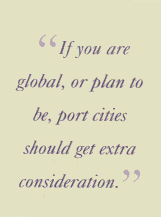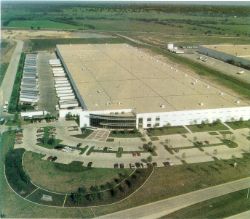Common business wisdom used to hold that if you built a better mousetrap, the world would beat a path to your doorstep. But that was before people started shopping over the Internet and expecting almost instantaneous delivery of the products they ordered.
Today, a growing number of customers demand exceptional logistics service from their vendors. As a result, running an efficient outbound distribution program has become increasingly important for every company interested in keeping and attracting customers. And employing the right logistics process has become one of the easiest ways to get a leg up on the competition.
There are many components to a logistics process. However one
of the most critical — and easiest to control — is the distribution center, or centers, you use. With that in mind, here are seven tips to help make the distribution site-selection process a little more productive.
1. Define the acceptable limits of “on-time.” First and foremost, your center or centers of choice must be able to meet your customers’ demands for timely delivery. As a result, your search for the perfect distribution center should start with a concrete definition of what “on-time” means.
Much of the definition depends on what your customers think is a reasonable turnaround time from order to delivery; this expectation that can vary significantly from company to company and industry to industry.
For example, a catalogue clothing company may find that its customers are more than content to have their orders shipped to them within a week to ten days. By contrast, a company that makes replacement parts for mainframes may find that its customers think that even a day is too long to wait, and that its customers will very rapidly switch vendors if their needs aren’t met.
Another litmus test is the nature of the product and the potential consequences of a late delivery. For example, fresh produce that languishes on the loading docks too long could end up in trash bins instead of grocery bins. And a short supply of some products, such as heart replacement valves, could truly turn out to be a life-or-death situation. Companies who carry these products will, quite naturally, have stricter standards for on-time delivery.
2. Determine how many distribution centers you want. The second key issue to consider is how many distribution centers you want to operate. It’s an important question for two reasons.
First, it could have a substantial impact on the cities you choose as distribution points. For example, if you elect to operate only one distribution center, you’ll probably wind up in a major population center, like Chicago, or a city located close to the center of the country, such as St. Louis. By contrast, if you opt for several distribution centers, you might end up in more geographically dispersed markets, say Denver, Seattle or Jacksonville.
The number of distribution centers you choose to operate also will affect the size of the distribution centers you look for in each market. The larger the number of facilities you use, the smaller each facility should be.

Consultants and third-party logistics providers are frequently
asked what the magic number of distribution centers is. Unfortunately, there’s no single right answer, although the national average skews to between three and four distribution centers. It depends on your budget, comfort level and customer needs as well as your ability to pay inventory carrying costs.
3. Select distribution markets. Once you’ve figured out how many distribution centers you want and how quickly you need to get product to customers, it’s time to compare specific distribution markets.
Here are just a few of the issues you should consider:
• Proximity to customers. As a general rule, closer is better. If most of your customers are in California, this will make a market such as Los Angeles more appealing than a market such as Fresno–unless you have days to make deliveries.
• The price of reaching customers from a particular market. Certain markets’ real estate prices are cheaper than others. However, you have to look at your distribution in terms of total cost, and that means factoring in the cost of transporting products from that market, too.
• The potential quality of a workforce in a given area. Despite major advances in technology, distribution is still a people-intensive process. Look carefully at the talent pool you can pull from in each market and at the prevailing wage rate. This is especially important these days, because unemployment is so low.
• Access to a good selection of transportation providers. Unless your whole logistics program is supported by an in-house fleet, you’ll want to have the option of working with a wide selection of less-than-truckload carriers. This increased competition should result in better service, higher availability and more attractive pricing.
• The quality of a market’s transportation infrastructure. Virtually every city of any size in the United States has roadways and airports. But there is a big difference in the number of small parcel flights that leave each day from places like Grand Rapids and places like Atlanta, and what time those shipments go out. If you ship a lot of urgent orders, you should probably restrict your search for distribution centers to markets with major airports or air hubs. And if you are global, or plan to be, port cities should get extra consideration.
• Weather. If your orders are especially urgent or last-minute in nature, at least one of the distribution markets you choose should be in an area where Mother Nature rarely if ever interferes with shipment schedules. This might rule out places like Buffalo or San Francisco as sole distribution sites.
Not surprisingly, comparing all of these criteria can take weeks or months. However, many site-selection software packages can at least make the process a little less painful. These packages enable you to compare any number of scenarios, such as establishing a two- or three-distribution-facility network, to help build the network that will best suit your needs. And the software enables you to pinpoint the best distribution markets based on your preferences, performance standards and budget parameters.
You can buy such packages yourself, or you can use a consultant or third-party provider that has access to them. Either way, it’s money well spent.
4. Compare facilities within markets. Once you know what markets you want to be in, the distribution center site-selection process comes down to searching for and comparing individual facilities.
At last count there were about 250,000 distribution facilities located throughout the United States. But as any logistics professional will tell you, not all of them are created equal.
Among the things you should compare are:
• Access to roadways. At some point, most products move by truck–even if that truck goes straight to an airport or seaport. Unless you enjoy paying higher transportation bills, proximity to interstates and highways is essential.
• Number of truck doors. One sure way to create a distribution bottleneck is to get a facility with too few places for trucks to make pick-ups or deliveries. Your facility should have enough truck doors to facilitate the smooth flow of inbound and outbound shipments.
• Clean, well-sealed facilities. Most distribution facilities will look
clean to the naked eye. However there are a few tell-tale signs that can help you identify facilities where dust and other contaminants are likely to be a problem. These signs include daylight showing through closed dock doors and cracks in the floor.

• Climate control. A good number of distribution facilities do not have air conditioning or heating. So if you have a temperature-sensitive product, you’ll want to make sure your facility has some method of handling these sensitivities.
Additionally, if you decide to use a facility run by a public warehousing or contract logistics provider, you’ll want to weigh each provider’s strengths and weaknesses and ability to offer value-adding services. After all, a facility is only as good as the people managing it.
5. Compare costs, but be careful.
The next recommended step in distribution center selection is, perhaps, the most overrated and dangerous one, because it concerns money. Although you should always compare costs when choosing a distribution center, don’t let economy cloud your judgment. For one thing, the lowest rent or sale price doesn’t always equal the lowest cost. A facility’s additional expenses like taxes, insurance and utilities can have a substantial impact on the actual cost to operate it. So can its shape, age and height.
Bear in mind that your customer service could suffer if you automatically choose the cheapest facilities and markets. In order to find the distribution center that is truly the most cost-effective, you must look at the big picture, factoring in all the potential costs and benefits. Once you do this, you may end up choosing a completely different facility than the one you originally would have selected.
6. Improve your flexibility and compromising skills.
And now for the grim truth: Even if you conduct a rational, by-the-book search for the perfect distribution site, there are no guarantees that you will find it. This is especially true if you’re looking in such popular distribution
markets as Atlanta, Dallas or Los Angeles, where larger-sized facilities are in great demand, or in emerging markets like Mexico, where particular kinds of facilities don’t even exist.
When this happens, you have three options: You can search in another, comparable market. You can build a facility in your market of choice. Or you can go with a less-than-perfect facility and use technology to help improve it.
Software can help you figure out the best layout for your facility, the optimum methods of storage and the most efficient number of shifts. As a result, you can optimize your facility’s productivity. You can also take some consolation in the fact that your choice of facilities doesn’t have to be permanent.
Instead of buying a distribution center, you can always lease one, or you can use one operated by a contract logistics provider. This will buy you more flexibility to re-evaluate and reconfigure your distribution center network down the road, which brings us to the final piece of advice.
7. Don’t Assume you’re through.
Good logistics is a process, not an event. As a result, you can never assume that your site-selection job is complete. A distribution center that gets the job done today may not even come close tomorrow, because there are always fundamental shifts in how people buy and what they expect. And companies themselves are forever changing.
Many logistics experts recommend re-evaluating logistics configurations and centers once every couple of years. It may sound like a lot of work. But considering the potential payoff, it’s probably one of the wisest investments any company interested in progress can make, especially in a world where building a better mousetrap is now only part of the secret to success.
SS
